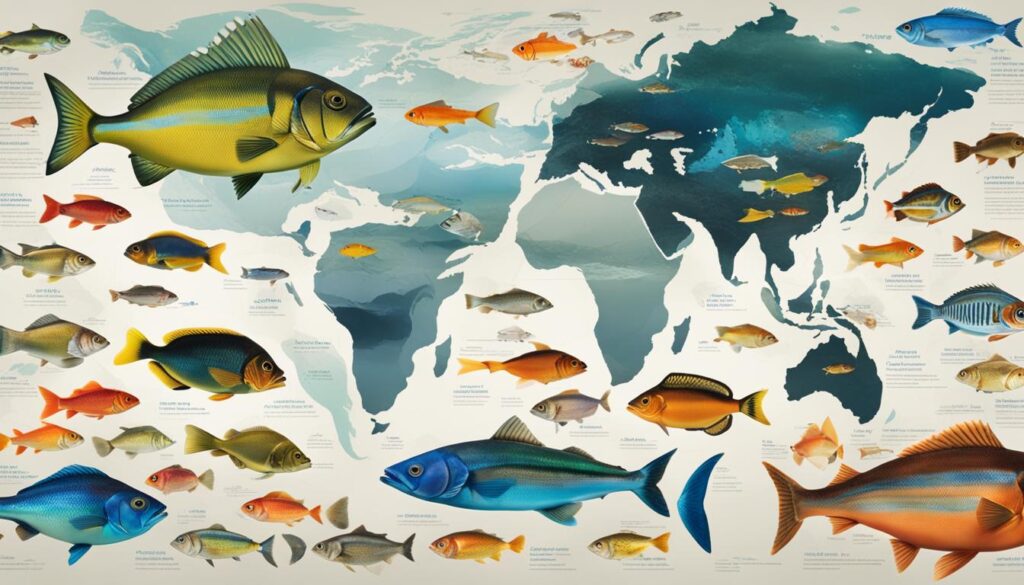We may earn money or products from the companies mentioned in this post.
Whether you are an avid fisherman or a curious observer of aquatic life, understanding fish species identification is a valuable skill. Not only does it give you the ability to confidently identify different fish species, but it also contributes to conservation efforts and maintaining a healthy ecological balance in aquatic environments.
In this comprehensive guide, we will take an in-depth look at fish species identification. We will cover various techniques, tools, and resources that you can use to identify different fish species across the United States. From identifying fish using physical characteristics and habitats to using modern-day fish identification apps, you will gain a wealth of knowledge and learn valuable tips for recognizing different fish species.
Key Takeaways:
- Fish species identification is a valuable skill that contributes to conservation efforts.
- There are various techniques, tools, and resources available for identifying different fish species.
- Identifying fish using physical characteristics and habitats is one of the traditional techniques.
- Modern-day fish identification apps are widely used and can help you more accurately identify fish species.
- This guide will provide you with valuable knowledge and tips for recognizing different fish species.
The Importance of Fish Species Identification
Accurately identifying different fish species is essential to preserving aquatic environments and conserving various species. Whether it be for scientific research, fishing regulations, or sustainable ecosystem management, understanding fish identification techniques is vital. Two main categories of fish include freshwater and saltwater species, each possessing unique physical characteristics.
Freshwater Fish Species Identification
Freshwater fish species live in bodies of water with salinity levels below 0.05% and can be identified through physical attributes such as body shape, coloration, and scales. A fish identification chart for freshwater species may also include information on habitat and diet, which can aid in discerning between similar species.
| Common Freshwater Fish Species | Physical Characteristics | Habitat | Diet |
|---|---|---|---|
| Bass | Large mouth, olive green coloring with light underside, black stripe running horizontally | Lakes, rivers, and ponds with vegetation or cover | Crayfish, insects, and smaller fish |
| Trout | Small mouth, varying colors depending on species, round spots along the back | Cold, clear streams and rivers with flowing water | Insects and small fish |
| Catfish | Whiskers, scaleless skin, flattened head, broad body | Rivers, streams, and lakes with slow-moving water and plenty of cover | Small fish, insects, and plant material |
Saltwater Fish Species Identification
Saltwater fish species live in oceans and other bodies of saltwater and can be identified through physical attributes such as size, shape, color patterns, and fin structure. Saltwater fish identification chart may also include information on where the species is typically found, which can help narrow down the identification process.
| Common Saltwater Fish Species | Physical Characteristics | Habitat | Diet |
|---|---|---|---|
| Tuna | Streamlined, dark blue or silver coloration, two dorsal fins | Open ocean | Small fish and squid |
| Barracuda | Long, slender body, sharp teeth, dark coloration with silver sides | Coral reefs | Small fish |
| Shark | Large, muscular body, pointed snout, sharp teeth, dorsal fin | Open ocean or near the shore | Other fish, squid, and marine mammals |
By familiarizing yourself with different fish identification techniques and charts, you can accurately identify different freshwater and saltwater species. This knowledge can assist in conservation efforts, such as monitoring populations and regulating fishing practices to promote sustainable aquatic environments.
Tools for Fish Species Identification
Proper fish species identification requires the right tools and techniques. Here are some tools you can use to identify fish species:
| Tool | Description |
|---|---|
| Fish Identification App | A mobile app that uses image recognition technology to identify fish species. You can take a photo of the fish, and the app will provide you with information about the species. |
| Fish Identification Techniques | There are many techniques for identifying fish species. These include examining physical characteristics such as the shape and color of the fish, as well as observing its behavior and habitat. |
| Fish Identification Guide | A field guidebook that provides detailed information and illustrations of different fish species. These guides often include identification keys that use a series of questions to help you narrow down the species. |
Using these tools in combination can enhance your fish species identification skills and provide a more comprehensive understanding of aquatic life.
Common Fish Species Across the US
The United States is home to a wide variety of freshwater and saltwater fish species. Understanding the distinguishing characteristics of these species is crucial for proper identification and conservation efforts.
Below are some of the most common species found across the US:
| Freshwater Fish | Saltwater Fish |
|---|---|
| Largemouth Bass | Striped Bass |
| Bluegill | Red Snapper |
| Trout | Tuna |
| Catfish | Mahi Mahi |
Freshwater Fish Species Identification:
Largemouth Bass: This is a popular game fish found in freshwater bodies such as lakes, rivers, and reservoirs. They have a greenish-brown color with a dark stripe down their sides and a large mouth that extends past the eye.
Bluegill: These fish are commonly found in small ponds, lakes, and slow-moving streams. They are small in size, typically around 8 inches long, and have a blue-green color with dark vertical bars on their sides.
Trout: Various species of trout are found throughout the US, including rainbow, brown, and brook trout. They prefer cool, clear water and are often found in streams and rivers. Rainbow trout have a distinctive pink-red stripe along their sides and a silvery body. Brown trout are brownish in color with dark spots. Brook trout have a dark green, almost black, body with light-colored spots.
Catfish: These bottom-dwelling fish are found in slow-moving streams, ponds, and lakes. They have a wide, flat head, and a whisker-like appendage called a barbel. Most species of catfish are brown or gray with dark spots.
Saltwater Fish Species Identification:
Striped Bass: This is a popular game fish found along the eastern coast of the US. They are silvery in color with 7-8 black horizontal stripes along their sides. They have a large mouth and sharp teeth.
Red Snapper: These fish are commonly found in the Gulf of Mexico and the southeastern Atlantic coast. They have a reddish-pink color with a white belly and a sharply pointed tail.
Tuna: Various species of tuna are found in the Atlantic and Pacific oceans. They are known for their speed and can grow up to 10 feet long. They have a dark metallic blue color on their backs and a silver underside.
Mahi Mahi: Also known as dolphin fish, these fish are found in warm ocean waters around the world, including the US. They have a bright greenish-blue color and distinctive yellow or green spots on their sides.
Conclusion
By now, you’ve learned the importance of Fish Species Identification and gained insight into the tools and techniques available for successful identification. Identifying fish species accurately is essential for conservation, fisheries management, and maintaining the ecological balance in aquatic environments.
This guide has provided you with the knowledge and resources to confidently identify fish species across the United States. Now you can appreciate the rich diversity of fish species found in our waters, whether you’re an angler, researcher, or a curious observer.
So, next time you’re out by the water’s edge, take a moment to observe the fish around you. With your newly acquired skills, you’ll be able to distinguish between different species and contribute to the conservation of these fascinating creatures. Thank you for taking the time to read this comprehensive guide to Fish Species Identification.
FAQ
What is fish species identification?
Fish species identification is the process of determining the specific species of a fish based on its physical characteristics, behavior, and habitat. It involves observing and analyzing various features such as body shape, coloration, fin structure, and other distinguishing traits.
Why is fish species identification important?
Fish species identification is important for several reasons. It helps in conservation efforts by allowing researchers and conservationists to accurately assess population sizes, monitor the health of fish populations, and implement targeted conservation strategies. It also aids in fisheries management, ensuring sustainable fishing practices and protecting vulnerable species. Additionally, fish species identification contributes to our understanding of aquatic ecosystems, helping to maintain the balance and health of these environments.
What tools can I use for fish species identification?
There are various tools available for fish species identification. One option is to use mobile apps specifically designed for fish identification, which utilize image recognition technology to match photographs of fish with known species. Traditional techniques such as using fish identification keys and guidebooks can also be helpful. These resources provide detailed descriptions and illustrations of different species, allowing you to compare physical characteristics and make accurate identifications.
Are there common fish species across the United States?
Yes, there are many common fish species found across the United States. These include popular freshwater species such as largemouth bass, trout, catfish, and bluegill, as well as saltwater species like striped bass, redfish, snapper, and grouper. Each region of the U.S. has its own unique mix of species, and familiarizing yourself with the common ones can enhance your fishing experience and appreciation for the diversity of fish in our waters.
Affiliate Disclosure: This post may contain affiliate links. If you purchase through our link, we may receive a small commission, but at no additional cost to you. For more information, please see our Disclosure statement.



